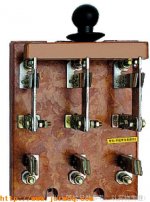evolvingpowercat
Well-known member
For sure I would de-power, open the transfer switch box, and in a couple of days and re-tighten all the connections. And for sure use some needle nose and wiggle those wires and tighten again if you have not done so already ! I have seen that kind of damage on a wire leading to a 30 amp electric dryer breaker that had a loose connection. Eventually the heat destroys something in my case the breaker finally failed due to the heat.
It appears that there is no vents of any kind on that box, so it looks like it worked like an oven and trapped all the heat inside cooking more than just the wire connection that was generating all the heat. Chances are that it was all caused by one loose neutral or hot on the shore cable lugs or on the lugs on the wiring going to the breaker panel. Assume you are like most and use your generator infrequently so not likely was one of those.
One thought - you could take one of the little indoor/outdoor LCD thermometers that sell for $10 and tape the outside sensor on the top of the metal transfer case box and then you could view its temp and compare it to the air temp in the basement where its located and it would give you a heads up that something is getting warm in there.
Personally I check all the AC and DC connections I can readily get to in my Edge every season. The first time I did it after I bought the Edge used there were some that could be tightened some, but they have all stayed tight since.
It appears that there is no vents of any kind on that box, so it looks like it worked like an oven and trapped all the heat inside cooking more than just the wire connection that was generating all the heat. Chances are that it was all caused by one loose neutral or hot on the shore cable lugs or on the lugs on the wiring going to the breaker panel. Assume you are like most and use your generator infrequently so not likely was one of those.
One thought - you could take one of the little indoor/outdoor LCD thermometers that sell for $10 and tape the outside sensor on the top of the metal transfer case box and then you could view its temp and compare it to the air temp in the basement where its located and it would give you a heads up that something is getting warm in there.
Personally I check all the AC and DC connections I can readily get to in my Edge every season. The first time I did it after I bought the Edge used there were some that could be tightened some, but they have all stayed tight since.



